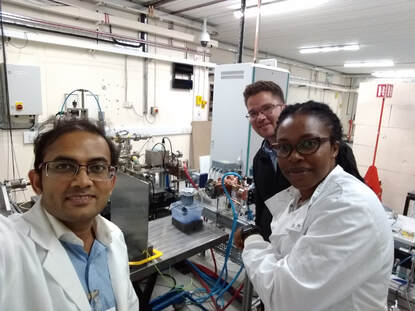 Scoping project team (University of Surrey and STFC Daresbury) working at the Compact Linac facility, STFC Daresbury laboratory. (Photo Credit Devendra Saroj) Scoping project team (University of Surrey and STFC Daresbury) working at the Compact Linac facility, STFC Daresbury laboratory. (Photo Credit Devendra Saroj) Across the world, many communities are already experiencing increasing droughts due to climate change. As the global population increases, securing enough supplies of clean, safe freshwater is a critical priority and using our current resources more efficiently needs to be part of this. Since farming is one of the largest consumers of freshwater, reusing waste water within agriculture could have a significant impact, however existing techniques are limited and difficult to apply at scale. But exciting pilot studies funded through the STFC Food Network+ are already bearing fruit – quite literally – in finding an alternative approach. “The novel aspect of this project is that we are using an established technique for a purpose it has never been used for before - to purify waste water” says project lead Devendra Saroj, Head of the Centre for Environmental Health and Engineering at the University of Surrey. The main issue with using waste water from industrial sources within agriculture is the presence of contaminants which can then accumulate in plants and seeds. Devendra’s approach is based on treating waste water with pulses of electrons that will react with organic compounds and instantly degrade them. Similar electron beams are already used widely in other applications, such as the security and health sectors. “Ultimately, using electron beams could purify wastewater to a very high standard within minutes” Devendra says. This is in stark contrast to existing membrane-based purification methods which can take several hours. His initial results on wastewater samples from textiles and mixed industrial uses are already promising, with over 95% of organic compounds being removed. “This is on a par with conventional techniques but much faster” Devendra says. To assess whether this water could safely be used for agricultural purposes, the team have been testing the purified water on plants (such as lettuce and beans) grown in petri dishes. Reassuringly, the results showed little difference between tap water and the purified wastewater, with the seedlings appearing completely healthy with no growth defects. “We are now talking with companies who specialise in hydroponic growing systems, to test this water on vegetables grown commercially” says Devendra. “Since these are closed agricultural systems, these could potentially be coupled to places where waste water is generated”. Another long-term goal is to use wastewater from actual farms, for instance to purify water containing run-off from organic fertilisers. But the immediate issue is to scale-up the process, since the current bench-size prototype model is only capable of handling sizes up to a litre. This may require a fundamental shift in production processes as Devendra explains: “Most electron beam applications are for scientific uses in laboratory settings. Manufacturers will have to adapt the instruments if they are to be used mainstream”. With so many factors to consider, including cost, ease of use and electron beam concentration, these proof-of-concept results will play a key role in convincing manufacturers to take up the challenge. For Devendra, the project illustrates perfectly the STFC Food Network’s goal of catalysing new ideas through bringing different disciplines together. “I would encourage researchers to participate in the network, even if they don’t see an immediate connection to their work” he says. It was through one of the Food Network’s Sandpit events, for instance, that he met physicists who develop accelerators that create electron beams. “They hadn’t thought of using this technology in an application like water recycling but with my environmental background I saw the opportunity” Devendra says. “I enjoy actively participating in the STFC Food Network because it allows me to bring my skills and contribute to areas that I don’t have specific expertise in, such as climate change. Bringing different disciplines together allows problems to be addressed from different angles”. With particular thanks to Dr Donna Pittaway at STFC Daresbury Laboratory
2 Comments
Umar Wabi Abubakar
29/8/2021 06:07:32 am
How can I be involved in this great research work, I found these very interesting and similar ones I have read on your profile. Currently I just finished my course work in the federal university of technology minna, Nigeria want to start my project work {THESIS}and still confused and don't know area to work on can you please assist I can be reached through my mail [email protected] or [email protected].
Reply
Your comment will be posted after it is approved.
Leave a Reply. |
AuthorJune 2024 - Archives
June 2024
Categories |
- Home
- Webinars and Events
- About the SFN+
- News
- Blog
- Expert Working Groups
- Funding
-
Publications
- Bioeconomy positioning paper
- SFN+ 5th Annual Conference
- OMM Policy Report
- ‘Multi-Stakeholder International One Day Workshop on Organic Agri-Food Value Chains for Net Zero’ Report
- SFN 2050 UK Net Zero Food report
- Sustainable Cold Food Chain Booklet
- Food Sensing Technologies for Safe and Nutritious Food
- Sustainable urban and vertical farming
- Projects
- Join/Contact Us


 RSS Feed
RSS Feed


